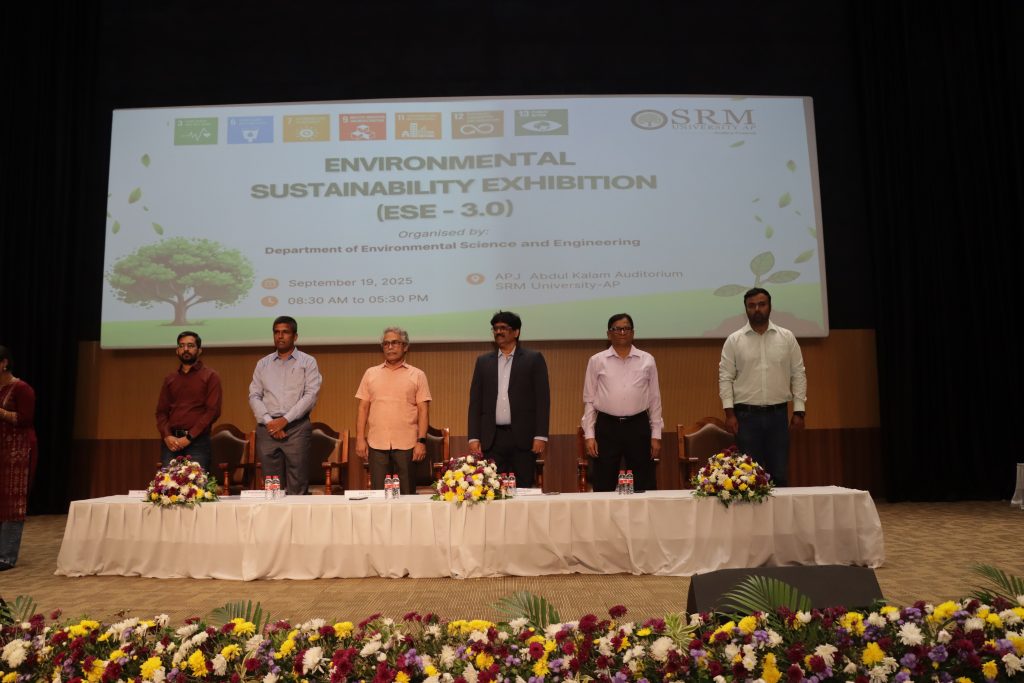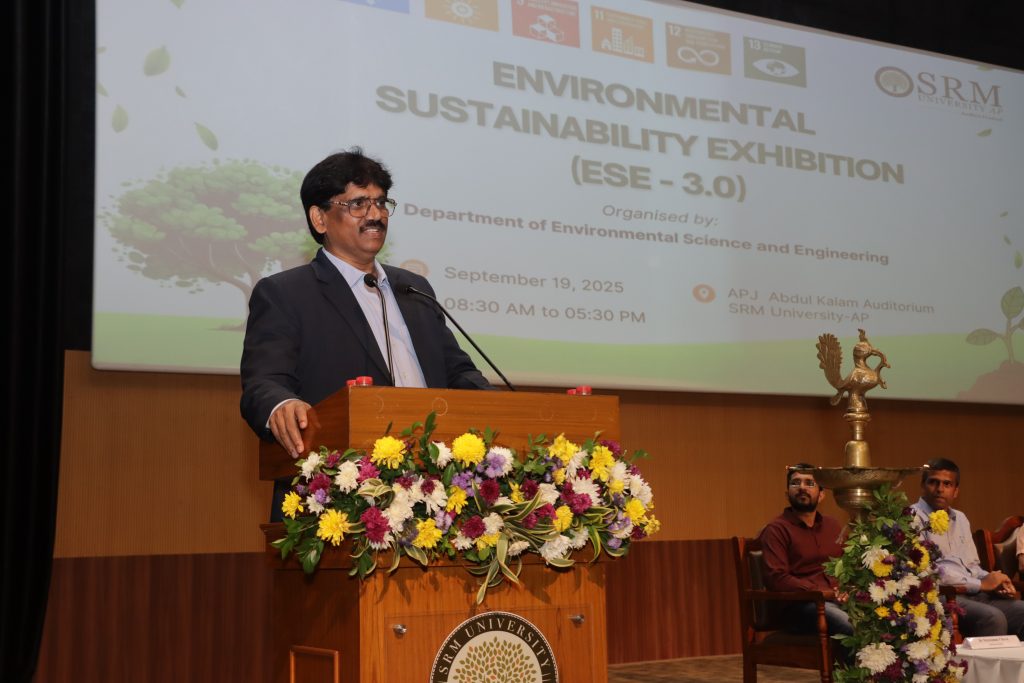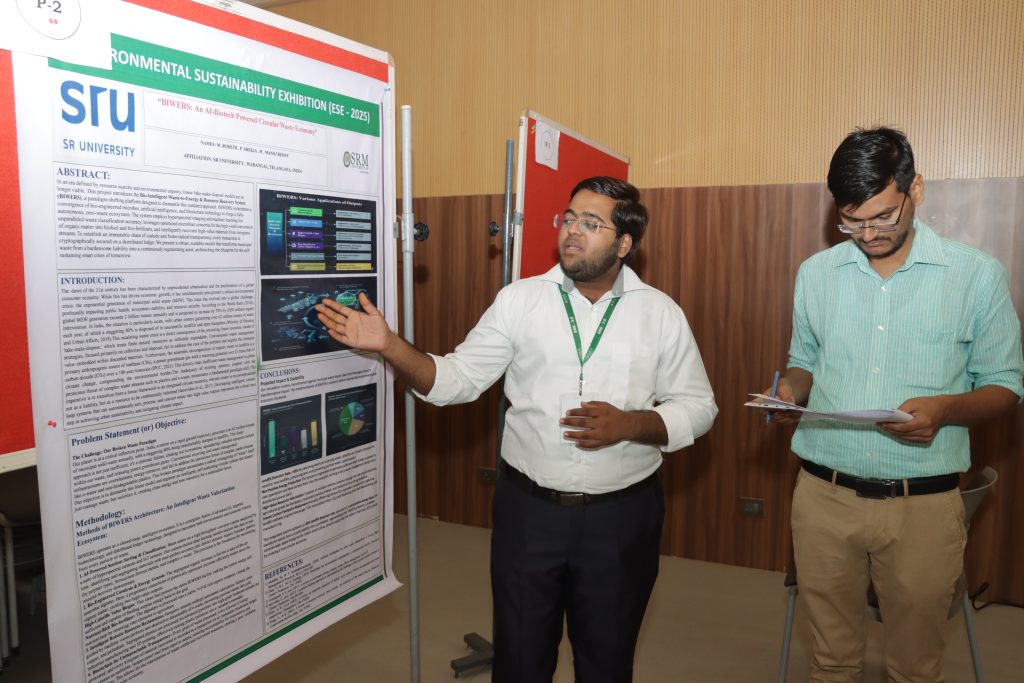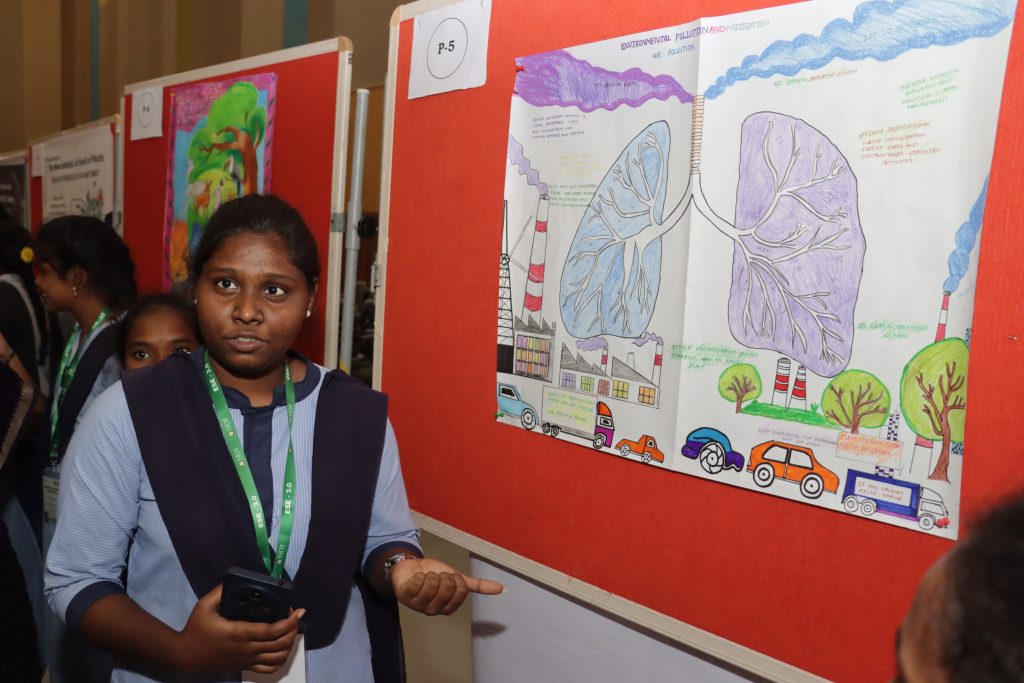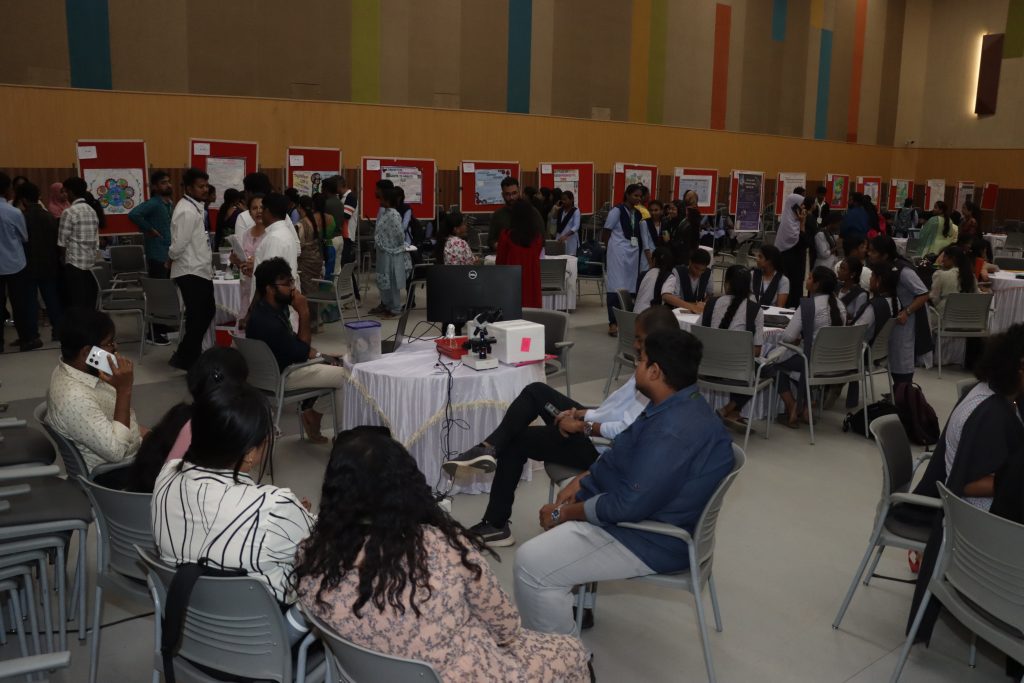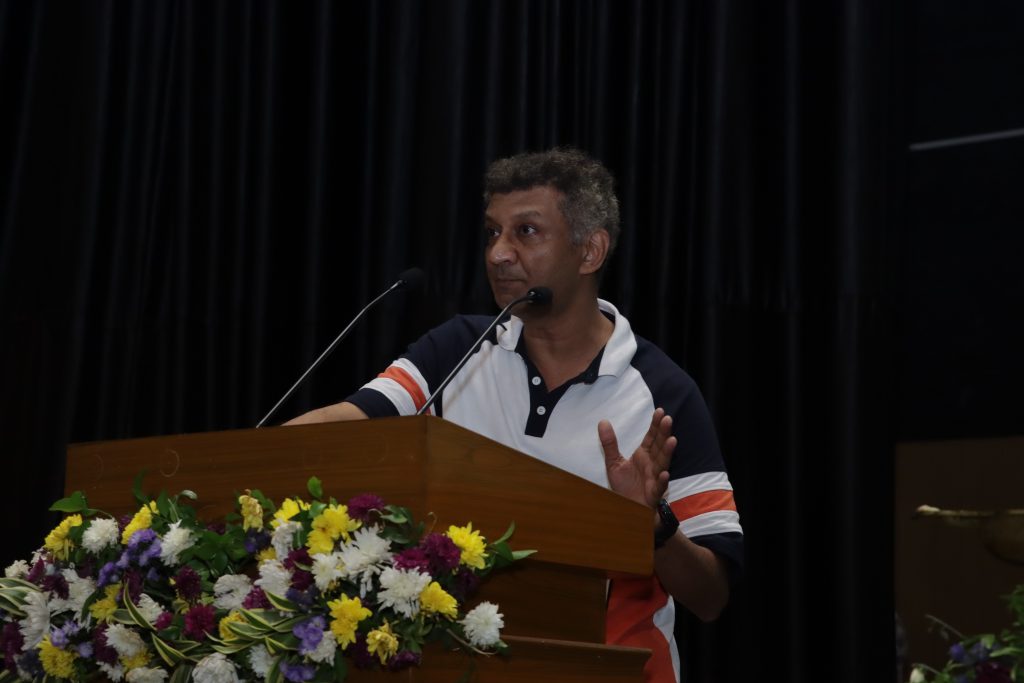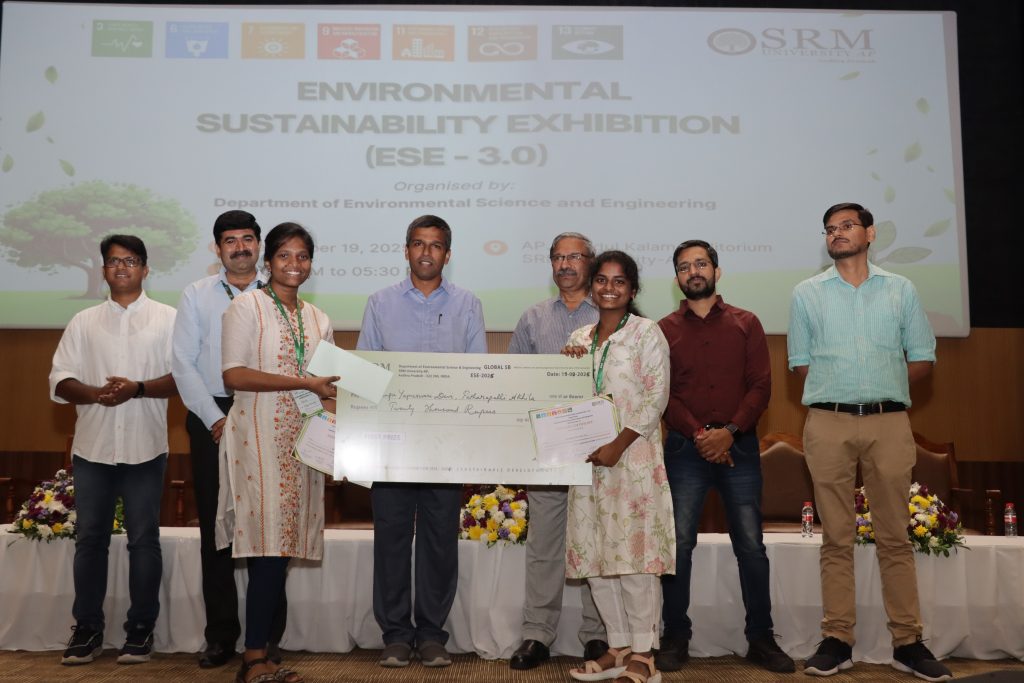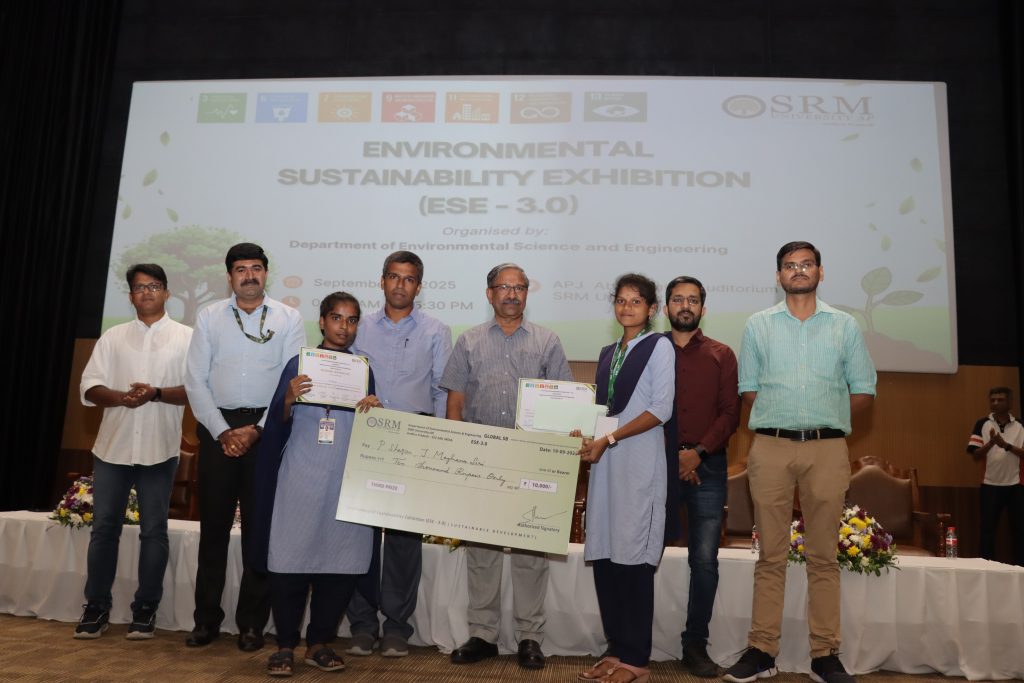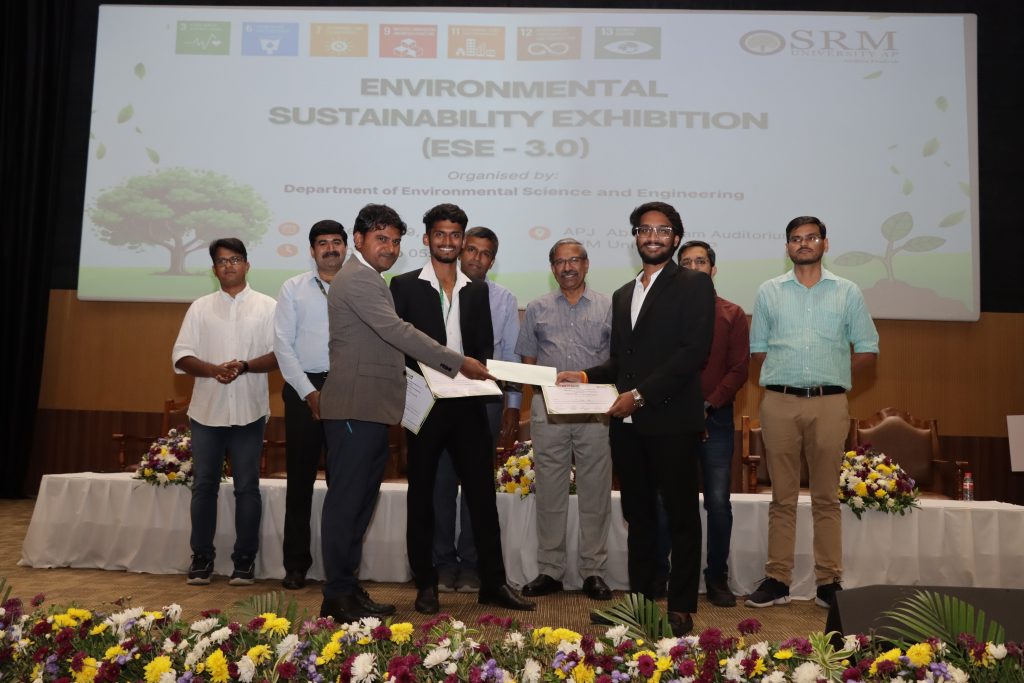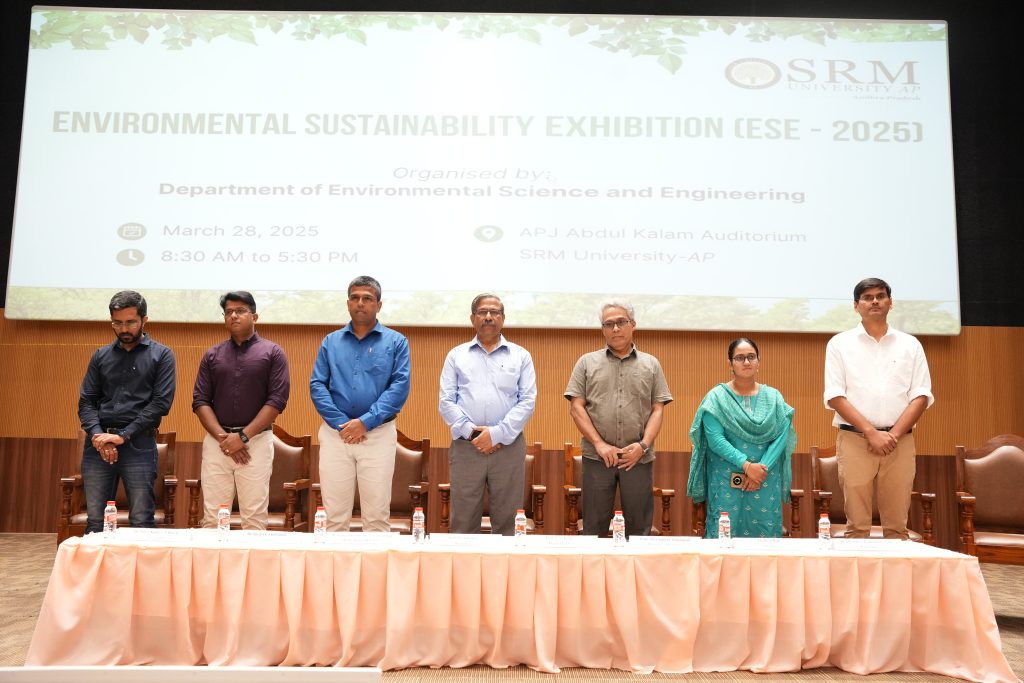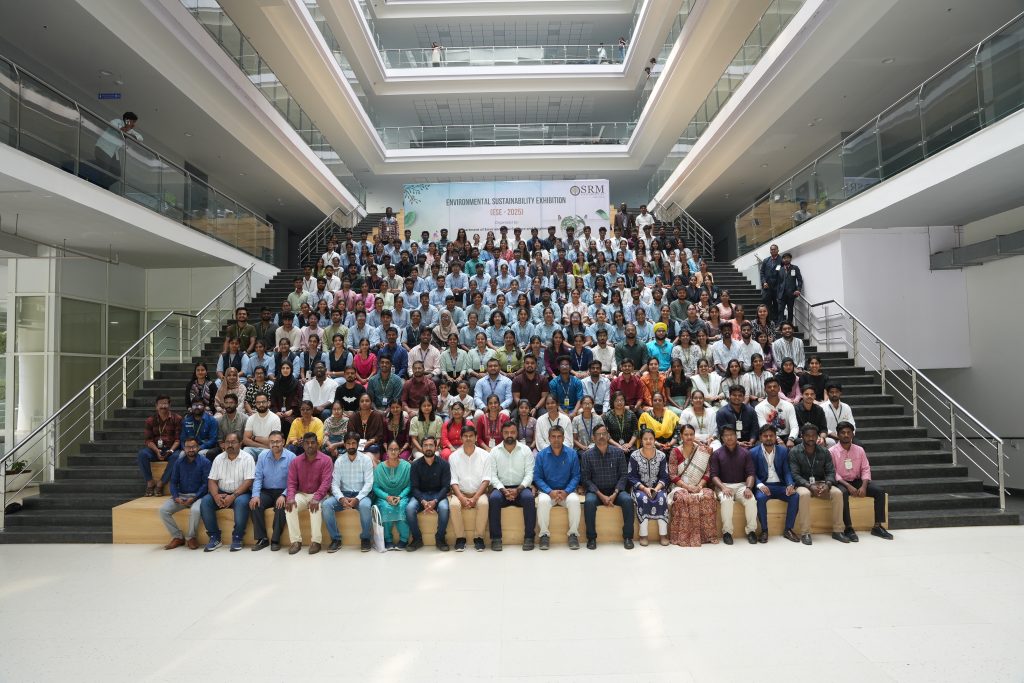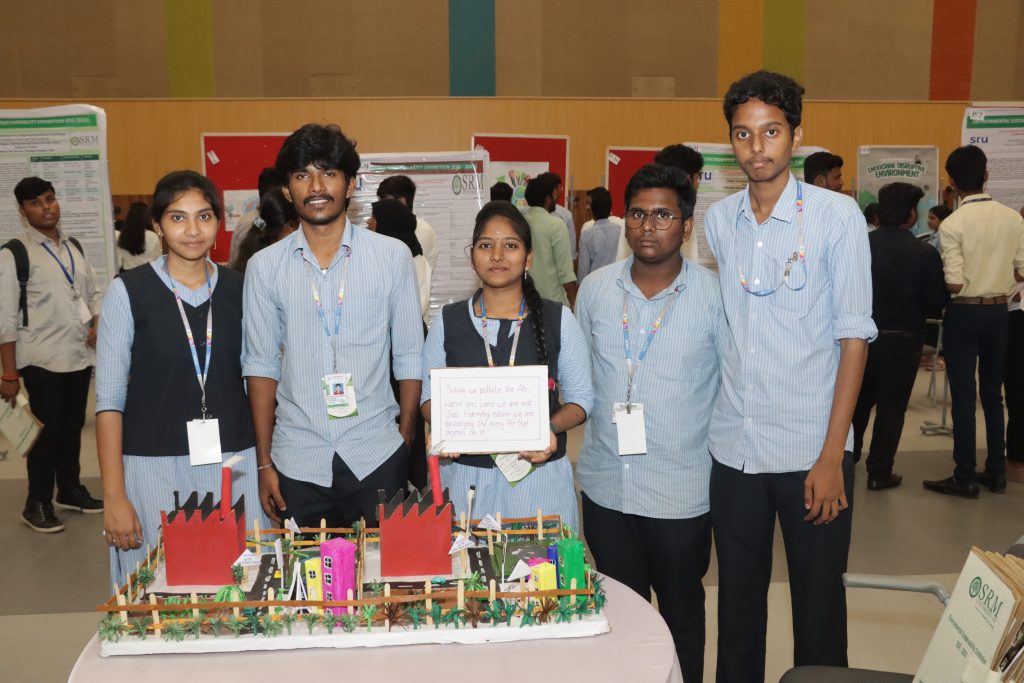Innovating for a Greener Future: Environmental Sustainability Exhibition 3.0 at SRM AP
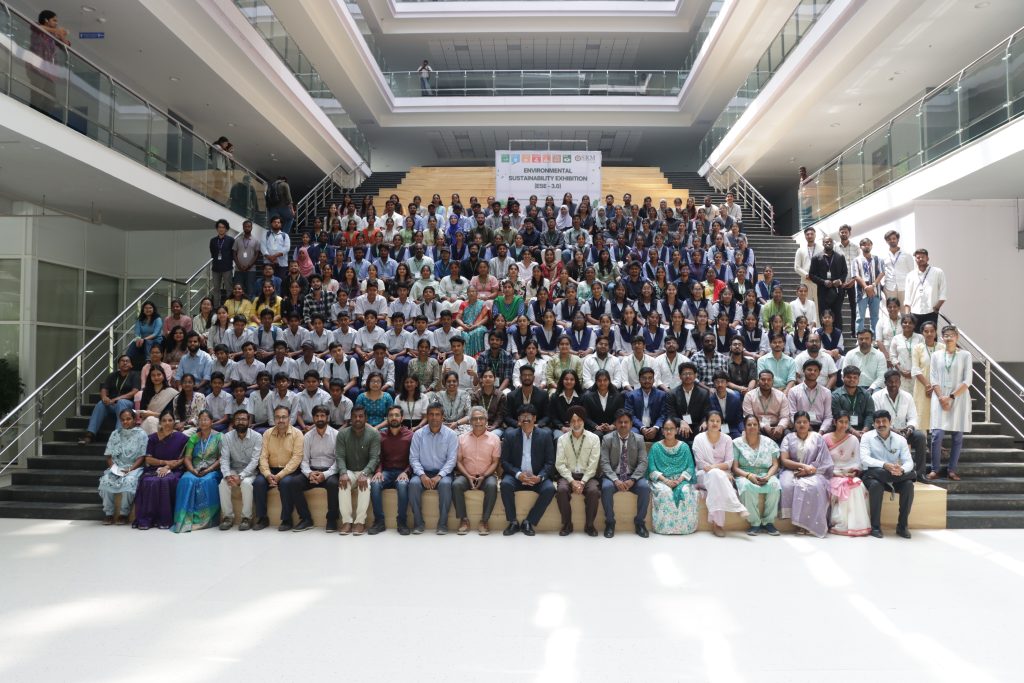
The Department of Environmental Science and Engineering, successfully hosted the third edition of the Environmental Sustainability Exhibition (ESE 3.0), a national-level platform dedicated to advancing knowledge, innovation, and collaboration in environmental protection and sustainable technologies, on September 19, 2025.
The event was inaugurated by Prof. Ch Satish Kumar, Vice Chancellor (I/C), who declared the exhibition open in the esteemed presence of Prof. C V Tomy, Dean of the School of Engineering and Sciences, Dr Rangabhashiyam Selvasembian, Associate Professor and Head of the Department of Environmental Science and Engineering, along with the, Heads of Departments, faculty members, staff, and students from various Universities and schools around the region.
In his inaugural address, Prof. Satish Kumar, Vice-Chancellor (I/C) , connected the exhibition’s vision to global efforts, stressing, “Sustainability is not an abstract idea but a responsibility towards future generations. Platforms like ESE 3.0 enable students to dream, innovate, and contribute to India’s commitment towards the United Nations’ Sustainable Development Goals and the Paris Climate Agreement.” He also emphasised the importance of achieving net zero emissions, drawing examples from states like Sikkim and nations like Bhutan.
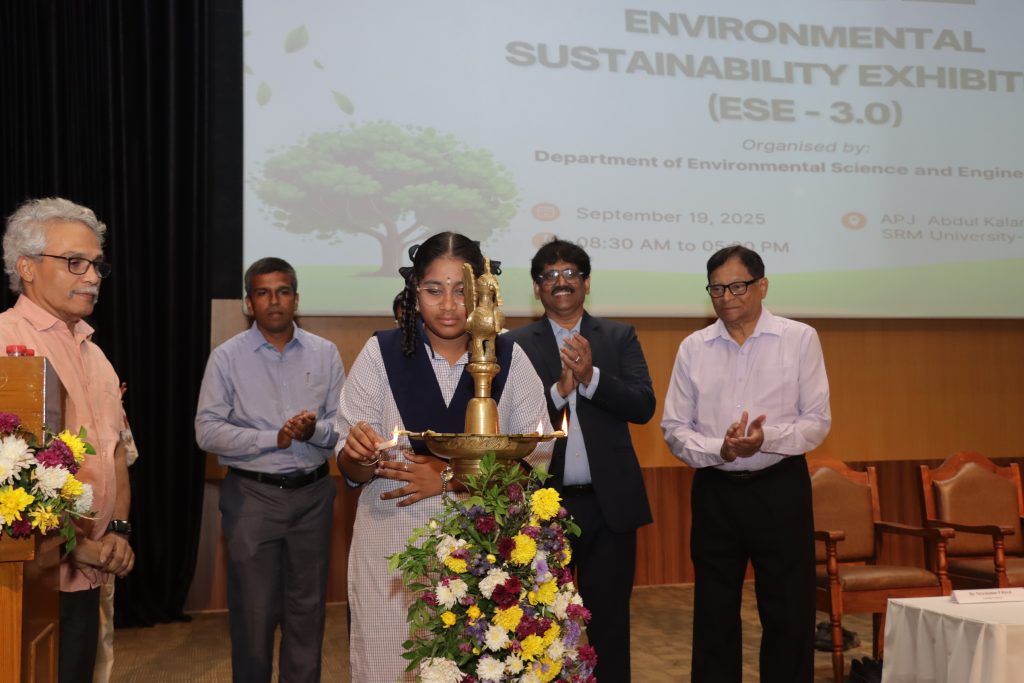
Carrying forward the legacy of the successful ESE 1.0 (2024) and ESE 2.0 (March 2025), this edition brought together 155 participants, hailing from states such as Punjab, Bihar, Telangana, and Andhra Pradesh. Around 60 exhibits, including 23 posters, 10 demos, and 25 oral presentations, represented prestigious colleges and universities nationwide. Each showcased innovative ideas rooted in their local contexts and challenges.
The top three winners were awarded a prize pool of ₹20,000, ₹15,000, and ₹10,000. Team P Akhila & V Yagneswari (Aditya University) secured the first prize, followed by Swarna Baisa & Bhanu Naik Jaloth (SR University, Warangal) and J Meghanasiri & P Sharon (SRR & CVR Govt. Degree College), who were awarded the second and third prizes, respectively.
Addressing the gathering, Dr Rangabhashiyam Selvasembian noted: “ESE 3.0 serves as an exceptional platform for students across India to present innovative ideas and initiatives for building a sustainable future. It motivates them to showcase their projects, interact with experts, and contribute meaningfully to the ongoing discourse on sustainability.”
Prof. C V Tomy further emphasised the importance of personal responsibility in everyday choices: “Every technological advancement, while beneficial, has an environmental cost. Even small, mindful actions such as conserving water and electricity make a significant difference when adopted collectively. Cultivating these habits early is the foundation of sustainability.”
The exhibition highlighted themes of air and water pollution mitigation, resource optimisation, sustainable development practices, waste management, renewable energy, and circular economy models. Participants presented working models, prototypes, posters, and research-based solutions, fostering rich academic exchange and dialogue.
Beyond the exhibition stalls, the event also included Poster presentations on climate change, environmental health, and resource equity, Hands-on training sessions introducing sustainability-driven advancements, Laboratory and campus visits offering exposure to SRM-AP’s state-of-the-art facilities and cutting-edge environmental research infrastructure.
With enthusiastic participation, thought-provoking exhibits, and meaningful interactions, ESE 3.0 reaffirmed SRM University-AP’s role as a hub for environmental innovation and sustainability research, dedicated to shaping solutions for the most pressing global challenges.
- Published in Departmental News, ENVS News, News, Research News
Transforming Sustainability with Innovative Catalysts
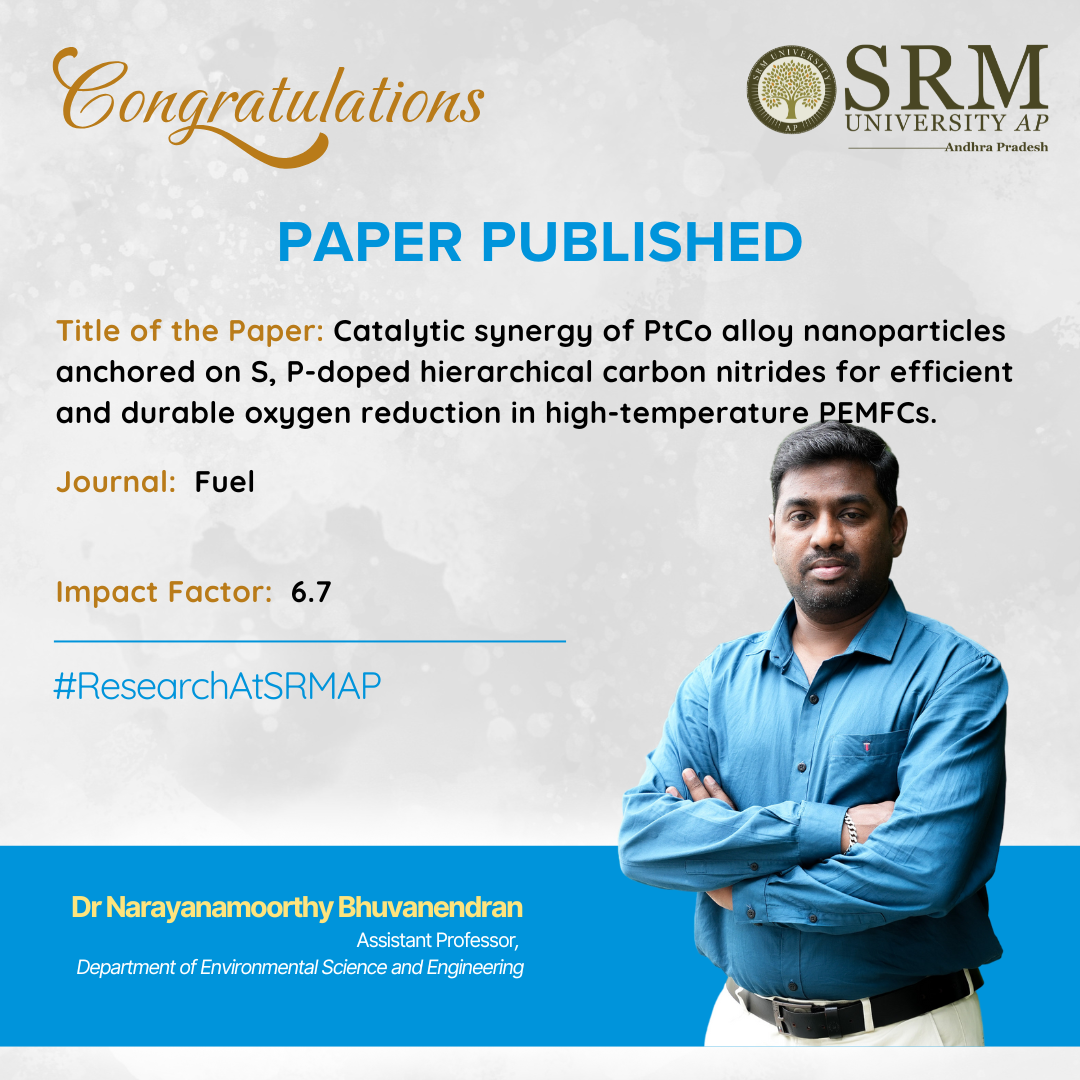 Assistant Professor, Dr Narayanamoorthy Bhuvanendran from the Department of Environmental Science and Engineering has published a research paper titled, Catalytic synergy of PtCo alloy nanoparticles anchored on S, P-doped hierarchical carbon nitrides for efficient and durable oxygen reduction in high-temperature PEMFCs. His research presents a new type of catalyst that could enhance the efficiency and longevity of fuel cells, making them more viable for sustainable energy applications.
Assistant Professor, Dr Narayanamoorthy Bhuvanendran from the Department of Environmental Science and Engineering has published a research paper titled, Catalytic synergy of PtCo alloy nanoparticles anchored on S, P-doped hierarchical carbon nitrides for efficient and durable oxygen reduction in high-temperature PEMFCs. His research presents a new type of catalyst that could enhance the efficiency and longevity of fuel cells, making them more viable for sustainable energy applications.
Abstract:
Intensified electrochemical corrosion under high-temperature and phosphoric acid conditions poses a significant challenge to the catalysts in high-temperature proton exchange membrane fuel cells (HT-PEMFCs). Herein, a S, P-doped hierarchical porous carbon nitride (S, P-HCN) supported PtCo alloy catalyst was developed to address this issue. The multilayered porous structure of S, P-HCN ensures high metal dispersion, a large specific surface area, and enhanced mass transfer. The PtCo/S, P-HCN catalyst exhibits remarkable performance, with specific activity (1.27 mA cmPt-2 at 0.80 V), mass activity (0.51 mA µgPt-1 at 0.80 V), and electrochemical active surface area (ECSA) (39.9 m2 g-1Pt), surpassing commercial 20 % Pt/C by 2–3 times. Durability tests over 5000 potential cycles reveal excellent retention of mass activity (84 %) and specific activity (83.2 %) at 0.80 V, with only a minor 14 mV shift in half-wave potential. This enhancement stems from the synergistic effects between PtCo alloy nanoparticles and S, P-HCN, which modulate Pt- electronic structure, strengthen metal-support interactions, and boost catalytic efficiency. Single-cell HT-PEMFC studies demonstrate a peak power density of 377.4 mW cm−2 for PtCo/S, P-HCN, comparable to commercial Pt/C (398 mW cm−2), with reduced voltage degradation at low current densities. This work presents a promising approach for improving cathode materials and advancing HT-PEMFC performance.
Explanation in Research in Layperson’s Terms:
The growing demand for green energy has increased the interest in clean, sustainable, and efficient fuel for electricity generation. Hence, hydrogen is one of the promising choices as green energy source, which can be used as a fuel in fuel cell technology. Among various types of fuel cells, proton exchange membrane fuel cells (PEMFCs) are the fastest-growing energy technologies, especially in automotive applications, owing to their high-power density and rapid start-up and shutdown capabilities compared to other fuel cell types. PEMFCs are classified by operating temperature into low-temperature (LT-PEMFC) and high-temperature (HT-PEMFC). While LT-PEMFCs (operating at ∼ 80 °C) have advanced significantly, they face challenges such as complex heat and water management and the high cost of producing the required high-purity hydrogen fuel. HT-PEMFCs, operating at 150–200 °C, overcome low-temperature PEMFC limitations with fuel flexibility, simpler design, improved water management, and greater efficiency, while enhancing oxygen reduction reaction (ORR) kinetics and diffusion processes. Till to date, Pt/C is the most used catalyst in PEMFCs due to its high activity and stability. However, in HT-PEMFCs, phosphate species from the phosphoric acid electrolyte strongly adsorb onto Pt surfaces, blocking active sites for O2 adsorption and reducing overall cathode performance. To address this bottleneck issues, a novel hybrid support materials with 3D hierarchical porous morphology, high surface area, porosity, and more accessible active sites has been developed which provides distinct benefits over conventional carbon materials for enhancing ORR performance. Their extensive surface area and interconnected pores facilitate better active site distribution and efficient mass transfer during the ORR process and leads to extended fuel cell performance.
Practical Implementation and Social Implications:
In this work, we have design and developed the PtCo/S,P-HCN catalyst, through a simple hydrothermal process, constructs a synergistic combination of structural and compositional features that significantly enhance the cathodic ORR performance. The 3D porous architecture with uniformly distributed PtCo nanoparticles and S, P-doped carbon nitride matrix ensures improved Pt utilization, active site accessibility, and effective charge transport. Nitrogen doping (graphitic-N and pyridinic-N) facilitates efficient electron transfer, while heteroatom doping (S and P) optimizes *OOH binding energy, promoting oxygen adsorption and O–O bond cleavage. The interatomic alloy structure of PtCo modulates the Pt d-band center, further boosting ORR kinetics. These combined effects result in superior catalytic activity (SA: 1.268 mA cmPt-2, MA: 0.506 mA µgPt-1, ECSA: 39.9 m2 g-1Pt) and durability, retaining 84 % MA and 83.2 % SA after 5000 cycles with minimal half-wave potential loss (14 mV). In HT-PEMFC tests, it achieved a peak power density of 377.4 mW cm−2, matching commercial Pt/C (398 mW cm−2), while demonstrating greater PA resistance and stability. These findings highlight the synergistic effects of the PtCo/S,P-HCN catalyst and its potential as a robust ORR electrocatalyst for HT-PEMFC applications.
Collaborations:
Prof. Huaneng Su, Jiangsu University, China.
Future Research Plans:
Based on the observations from the above research, we plan to further explore modifications to the electronic properties of the catalyst to enhance the surface adsorption of reaction intermediates, thereby improving its electrocatalytic performance for various key electrochemical reactions.
- Published in Departmental News, ENVS News, News, Research News
A Sustainable Method for Recovery of Valuable Metals from LIBs
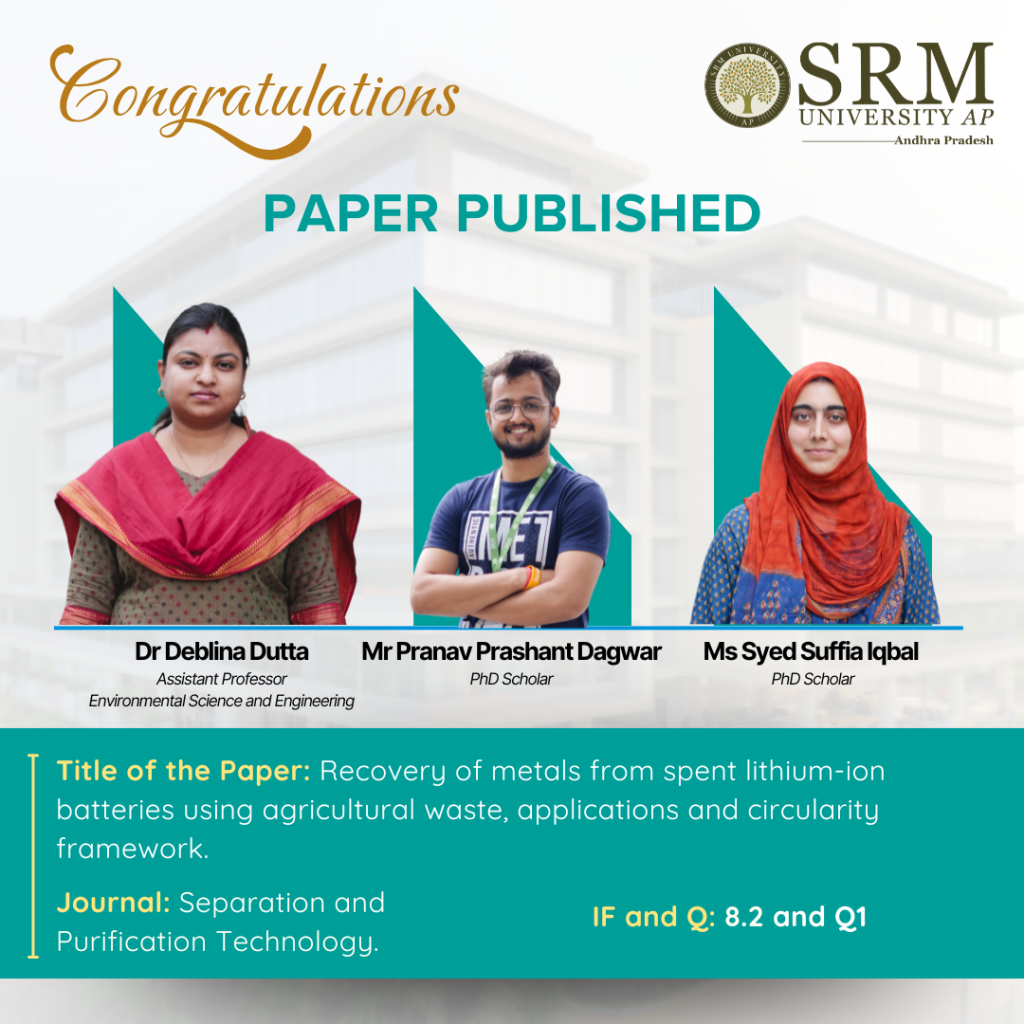
What happens when you can use natural waste like orange peels and rice husks to extract valuable metals from old batteries, electric vehicles, etc.? Exploring innovative and eco-friendly methods to recover useful metals, Dr Deblina Dutta, Assistant Professor, Department of Environmental Science and Engineering, and her research scholars, Ms Syed Suffia Iqbal and Mr Pranav Prashant Dagwar, have published a paper titled “Recovery of metals from spent lithium-ion batteries using agricultural waste, applications and circularity framework” in the prestigious Q1 journal Separation and Purification Technology having an impact factor of 8.2.
Abstract
This research explores an innovative, sustainable method to recover valuable metals (Li, Co, Ni, Mn) from spent lithium-ion batteries (LIBs) using agricultural waste such as rice husk, orange peels, tea waste, and sugarcane molasses. These organic wastes serve as eco-friendly, cost-effective leaching agents. The study compares conventional and biomass-based recovery methods, evaluates environmental impacts, and aligns the approach with circular economy principles to promote green technology and resource optimization.
Practical Implementation/ Social Implications of the Research
- Eco-friendly Recycling: Offers an alternative to hazardous chemical recycling by using biodegradable, non-toxic agricultural waste.
- Waste Valorisation: Transforms agricultural waste into a valuable resource, reducing landfill and open burning.
- Resource Recovery: Helps recover critical battery metals, reducing dependence on mining.
- Circular Economy: Supports sustainability goals by promoting a closed-loop recycling system.
- Policy Relevance: Aligns with SDGs such as clean energy (SDG 7), sustainable industries (SDG 9), and responsible consumption (SDG 12).
Collaborations
- Ain Shams University, Egypt
- Central Metallurgical R&D Institute (CMRDI), Egypt
Future Research Plans
- Scale up biomass-based metal recovery to pilot or industrial level.
- Develop hybrid leaching methods combining microbes and green solvents.
- Expand to rare earth element (REE) recovery from other waste streams.
Link to the article
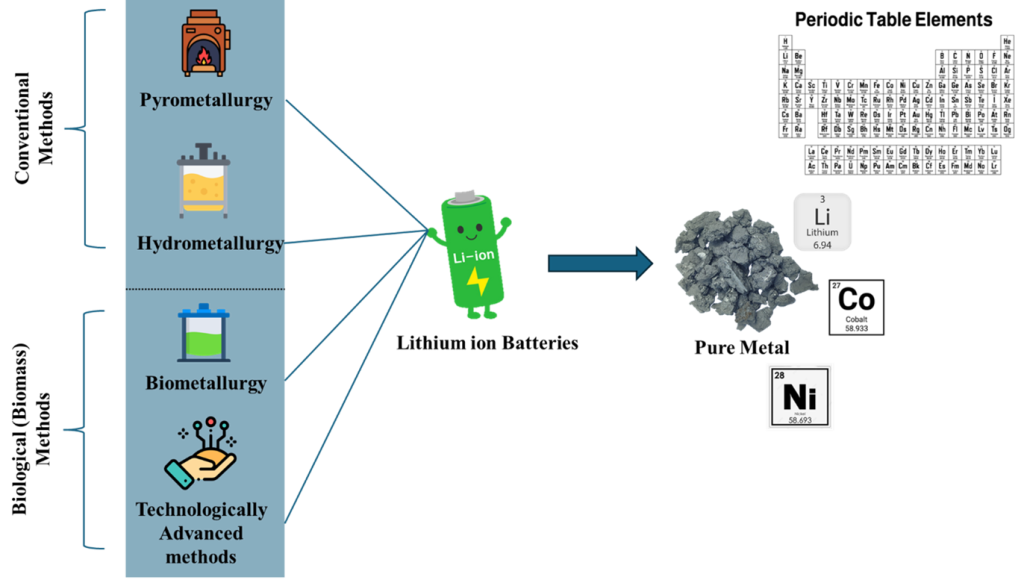
Fig. 2. Conventional and technologically advanced process for recycling LIBs.
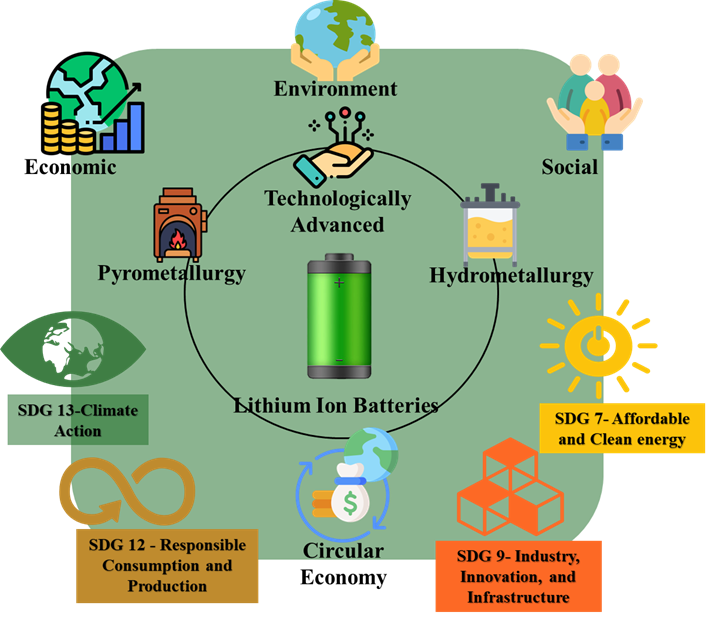
Fig. 9. Sustainability and circular economic applications in LIBs management.
- Published in Departmental News, ENVS News, News, Research News
Digestate Valorisation through Green Chemistry Technology
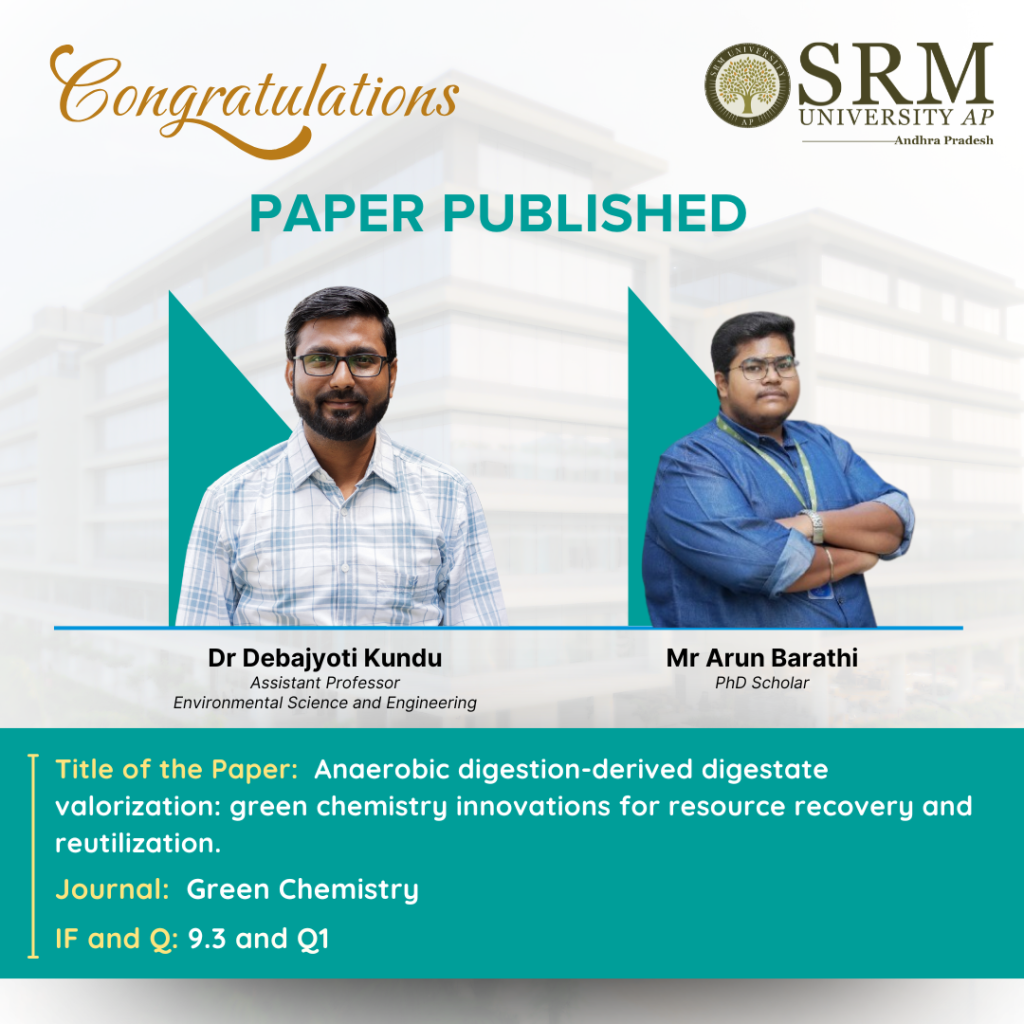
The proactive approach of Green Chemistry is driven by the cardinal rule of prevention rather than remediation of pollution. Analysing various eco-friendly ways to reduce waste, improve recycling, and help industries and farmers benefit from organic waste, Dr Debajyoti Kundu, Assistant Professor from the Department of Environmental Science and Engineering and his scholar Mr Arun Bharati, has published a paper titled “Anaerobic digestion-derived digestate valorization: Green chemistry innovations for resource recovery and reutilization”, in the Q1 journal Green Chemistry having an impact factor of 9.3.
Their research looked into eco-friendly ways to turn the bi-product of anaerobic digestion – digestate into valuable products like organic fertilisers, chemicals, and even ingredients for making plastics. The team also explores how to recover nutrients like nitrogen and phosphorus from it.
Abstract
Anaerobic digestion (AD) is a sustainable technology that converts organic waste into biogas, producing digestate as a by-product. This review investigates innovative strategies for digestate valorization through green chemistry approaches, emphasising its transformation into valuable resources such as biochar, bio-based polymers, and high-value chemicals like volatile fatty acids and humic substances. Additionally, the study explores nutrient recovery techniques like ammonia stripping and struvite precipitation. Through techno-economic and life cycle assessment perspectives, the work promotes digestate reutilization within a circular bioeconomy to enhance environmental sustainability and support net-zero goals.
Practical Implementation/ Social Implications of the Research
The research offers practical solutions for managing the large volumes of digestate generated in biogas plants. By converting digestate into biofertilisers, biochar, and industrial chemicals, we reduce the environmental burden of waste disposal and create economic opportunities for rural and urban stakeholders. These innovations support sustainable agriculture, reduce reliance on synthetic fertilisers, and promote clean technology, aligning with national and global sustainability goals, including SDGs and the circular economy.
Collaborations
The study was collaborative between SRM University–AP, SRMIST, Vignan’s Foundation, University of North Bengal, University of Burdwan, CSIR–NEERI, Thapar Institute, and Virginia Tech (USA).
Future Research Plans
The research lab focuses on the eco-friendly valorization of diverse organic wastes using green chemistry and sustainable bioprocessing approaches. We aim to develop scalable technologies for producing high-value biochemicals, enzymes, and biomaterials. These efforts are aligned with key UN SDGs.
Link to the article
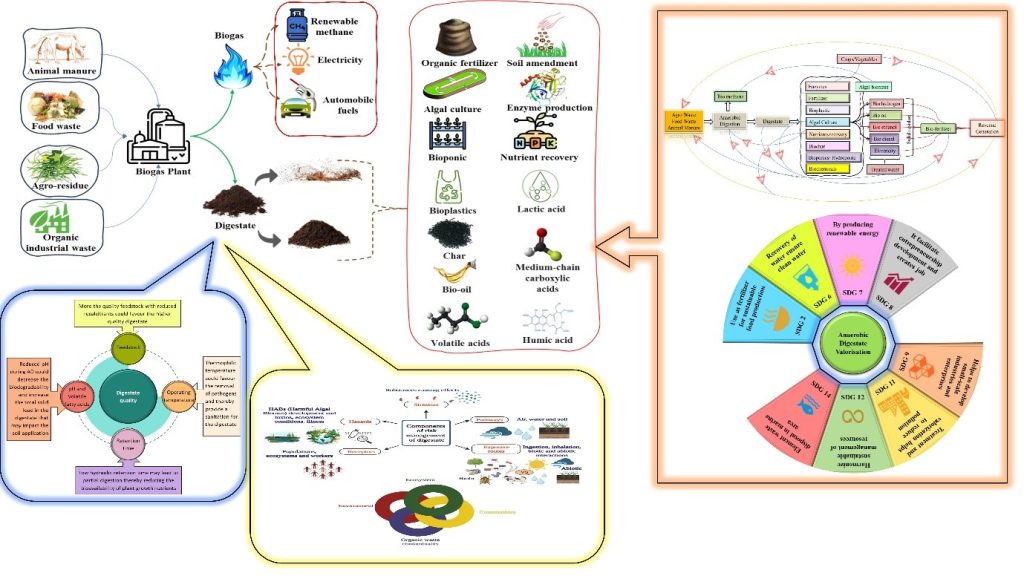
- Published in Departmental News, ENVS News, News, Research News
Microplastics: Hidden Drivers of Antimicrobial Resistance in Aquatic Systems
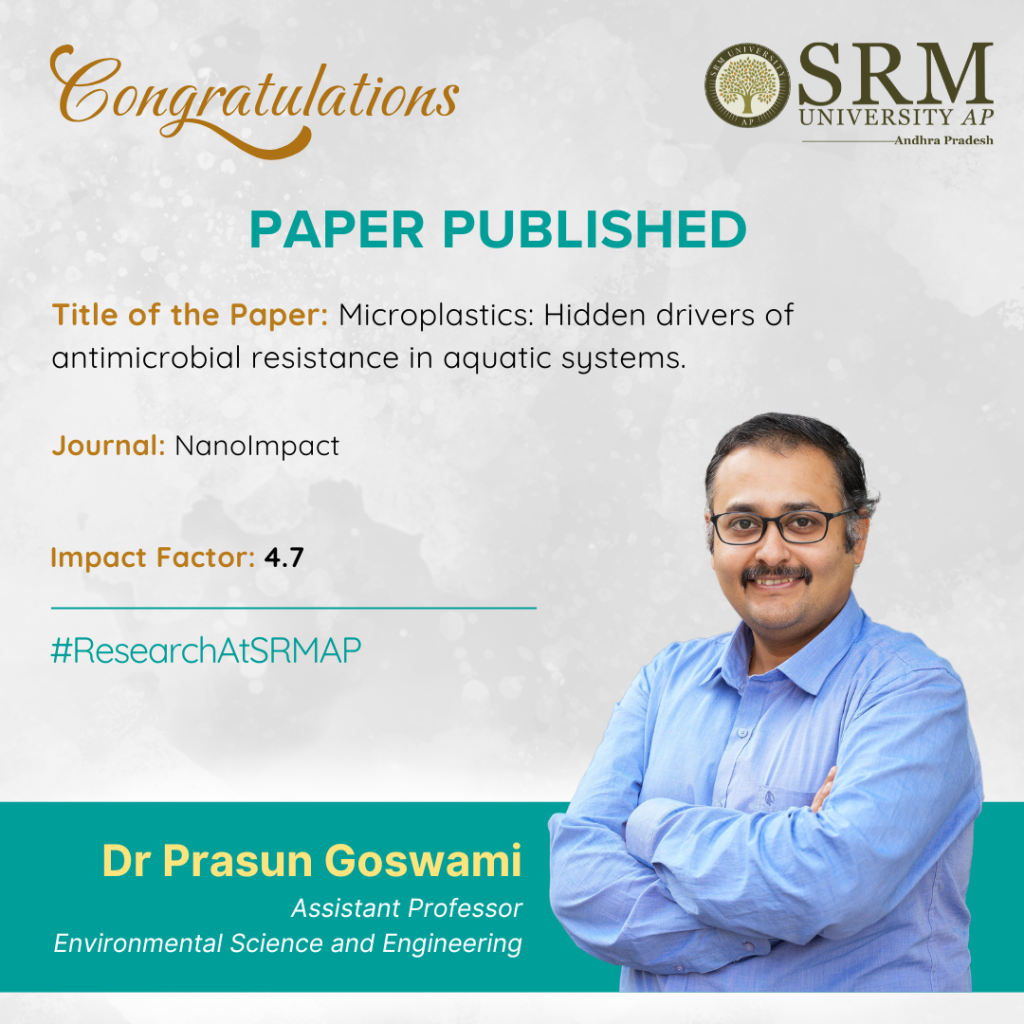
Dr Prasun Goswami, Assistant Professor from the Department of Environmental Science and Engineering, published a paper titled “Microplastics: Hidden drivers of antimicrobial resistance in aquatic systems”, in the Q1 journal, NanoImpact. His research reveals a concerning connection between microplastics and antimicrobial resistance in oceans. The study uncovers how microplastics in our oceans can harbour antibiotic-resistant pathogens, posing significant threats to marine ecosystems and human health. The paper not only sheds light on the topic but also proposes essential steps to better understand and manage the emerging threat.
Abstract
Tiny plastic particles, called microplastics, are commonly found in oceans, rivers, and lakes. These particles quickly gather layers of bacteria and other microbes, forming what scientists call the “plastisphere.” This plastisphere can carry harmful bacteria, including those that are resistant to antibiotics. Together, these plastic-based communities and the genes they carry make up what’s now being called the “Plastiome.” This review looks at how microplastics interact with bacteria and antibiotic resistance in water environments. It highlights how these plastics can collect and spread dangerous germs and genes that make infections harder to treat. The result is a growing health risk not just for marine life, but also for people. The review also points out areas where more research is needed and suggests ways to better understand and manage the spread of antibiotic resistance through plastic pollution in water.
Practical Implementation/ Social Implications of the Research
Understanding the Plastiome—the microbial life thriving on microplastics—is not just a scientific curiosity; it has real-world consequences. As these plastic particles travel through our oceans, they act as floating hubs for antibiotic-resistant bacteria, which can potentially enter the food chain via seafood or contaminate drinking water sources. The research highlights the urgent need for improved waste management, plastic use reduction, and policy frameworks to monitor microplastic pollution and its microbial cargo. By identifying how microplastics help spread antimicrobial resistance (AMR), the study can help inform public health strategies, guide marine conservation policies, and support international efforts to tackle both plastic pollution and the growing AMR crisis. In essence, tackling the Plastiome is not just about saving the oceans; it’s about protecting ecosystems, public health, and the future.
Collaborations
This work was conducted in collaboration with the National Institute of Animal Health, National Agriculture and Food Research Organization (NIAH-NARO), Tsukuba, Japan.
Future Research Plans
As part of the ongoing research, Dr Prasun explores how different plastic polymers interact with microbial communities and antibiotic resistance (AMR) genes in aquatic environments. Not all plastics behave the same—some may provide a more favourable surface for harmful microbes or facilitate the spread of resistance genes more efficiently. By understanding these polymer-specific interactions, he aims to identify which types of plastics pose the greatest environmental and public health risks. This research has important implications for designing safer materials, guiding environmental regulations, and developing strategies to curb the spread of AMR through plastic pollution in marine and freshwater ecosystems.</p
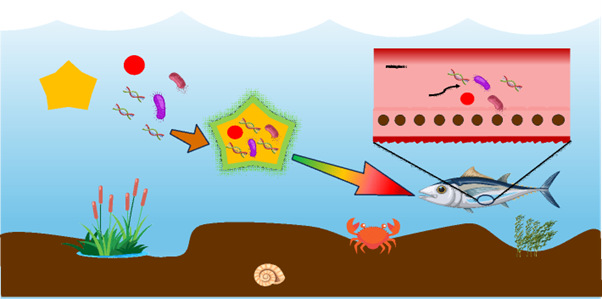
- Published in Departmental News, ENVS News, News, Research News
Breakthrough in Nanosecond Laser Conversion for Clean Energy
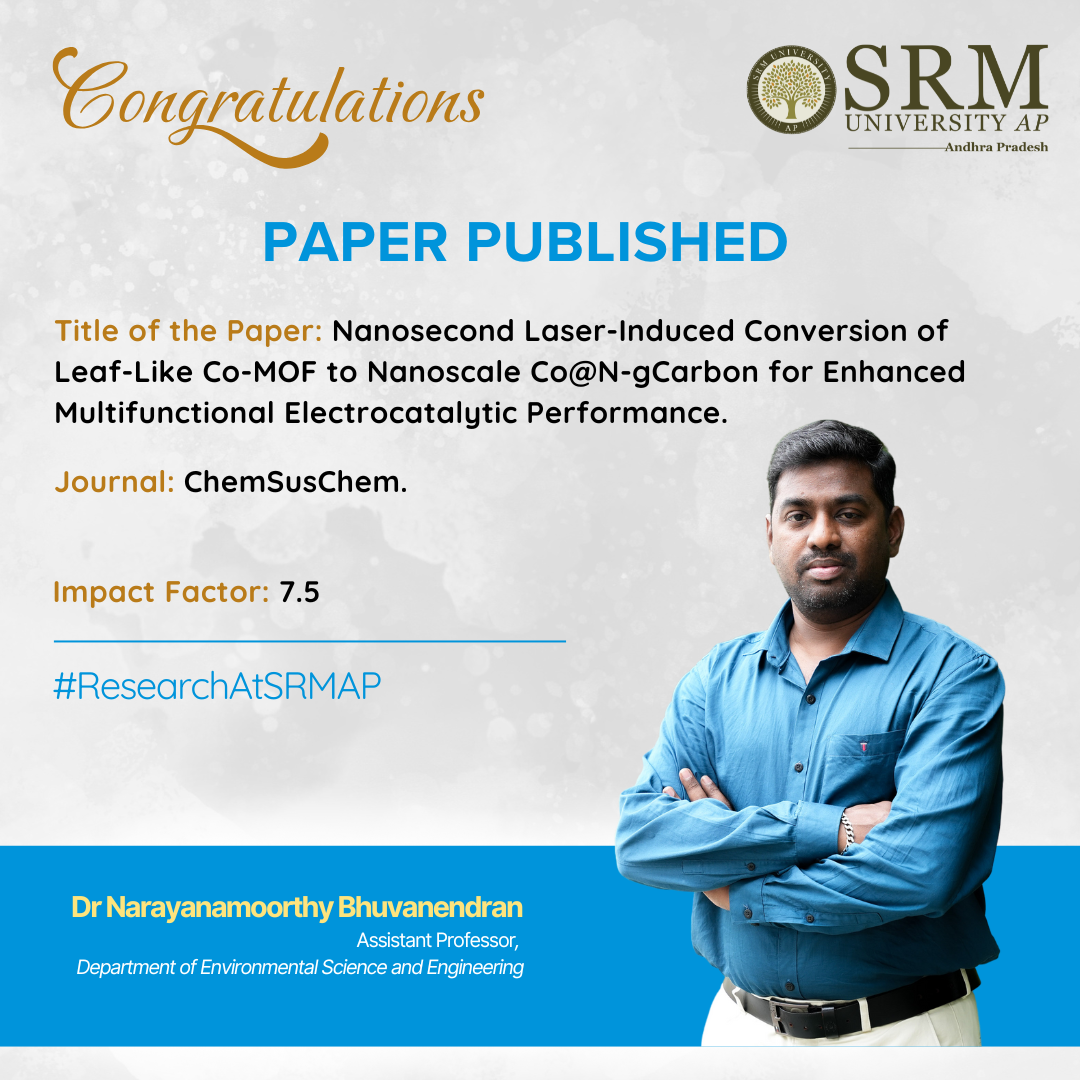
The paper titled “Nanosecond Laser-Induced Conversion of Leaf-Like Co-MOF to Nanoscale Co@N-gCarbon for Enhanced Multifunctional Electrocatalytic Performance” by Dr Narayanamoorthy Bhuvanendran, Assistant Professor, Department of Environmental Science and Engineering, was published in the ChemSusChem journal with a Q1 rating with an impact factor of 7.5. The study presents a breakthrough in clean energy research with an innovative nanosecond laser-based technique that transforms metal–organic frameworks into high-performance electrocatalysts faster, more energy-efficiently, and eco-friendly.
Abstract :
Conversion of metal–organic frameworks (MOFs) into metal-nitrogen-doped carbon (M–N–C) catalysts requires a high-temperature process and longer processing time under a protective atmosphere. This study utilises a low-energy nanosecond laser processing (LP) technique to convert aqueous synthesised 2D leaf-like Co-MOF (L-Co-MOF) into nanoscale cobalt metal encapsulated within a nitrogen-doped graphitic carbon matrix (Co@N-gC, Co-LP) in a shorter period under air atmosphere.
The laser-induced process results in the formation of Co@N-gC with smaller Co particle size, uniform distribution, and better interaction with the carbon support compared to the conventional pyrolysis process (CP). LP catalysts result in enhanced multifunctional electrocatalytic activity over CP (Co-CP) catalysts owing to the tunable metal–support interaction, higher charge transfer, and presence of multiactive sites.
Under optimised conditions (laser fluence: 5.76 mJ cm−2 and scan speed: 10 mm s−1), the Co-LP-5 catalyst exhibits better ORR performance, with onset and half-wave potentials of 0.92 and 0.76 V, respectively. Additionally, Co-LP-5 delivers excellent water-splitting performance, with OER and HER overpotentials of 380 and 280 mV, respectively, achieving an overall energy efficiency of 77.85%. Furthermore, Co-LP-5 demonstrates exceptional durability over 48 h of real-time testing, outperforming the Co-CP, and the proposed low-energy LP is viable for fabricating multifunctional catalysts.
The research focuses on developing new materials for more efficient clean energy production, specifically advanced catalysts that accelerate chemical reactions. Traditionally, creating an effective M–N–C (metal–nitrogen–carbon) catalyst requires heating metal-organic frameworks (MOFs) to high temperatures in oxygen-free environments, which is time-consuming and energy-intensive.
This study introduces a simpler, faster, and energy-saving approach using nanosecond laser pulses to transform cobalt-containing MOFs into a new material called Co@N-gC. This laser method operates in normal air, significantly reducing time and energy consumption. The resulting catalyst features smaller, evenly distributed cobalt particles that enhance interaction with the carbon support, leading to improved activity and efficiency in key energy reactions. Our laser-made catalyst, Co-LP-5, exhibited excellent performance over 48 hours, outperforming traditional methods. This breakthrough demonstrates that low-energy laser techniques can create powerful, multifunctional catalysts for clean energy more quickly, cheaply, and sustainably.
Practical implementation of the research :
We are working on developing new materials that help produce clean energy in a faster, cheaper, and more eco-friendly way. Usually, scientists use a high-heat process to convert materials called metal-organic frameworks (MOFs) into something called catalysts, which are substances that help speed up important chemical reactions, such as splitting water to produce hydrogen fuel or helping batteries and fuel cells work better.
However, the traditional method requires a lot of energy, time, and special conditions to work. In the study, we found a much simpler and faster way to make these useful catalysts. Instead of heating the material for a long time, we used a laser to quickly transform the MOF into a new material. We did this in normal air using short pulses of light from a laser, and within seconds, the material changed into a highly active form containing tiny cobalt particles surrounded by nitrogen-rich carbon. This new material works more efficiently and lasts longer than the one made by traditional heating.
Our method is not only quicker and more energy-efficient, but also easier to scale up for larger use. This laser technique can be used to create advanced materials for fuel cells, batteries, and systems that produce hydrogen from water. These technologies are crucial for clean energy and can help reduce pollution and dependence on fossil fuels.
The real-world impact of this research is significant. It can make clean energy technologies more affordable and accessible, especially in developing regions with limited energy access. It also supports the shift toward a greener economy by promoting sustainable methods and creating new opportunities in clean energy industries. In the long term, this work contributes to fighting climate change and protecting the environment by helping the world move toward cleaner, safer energy solutions.
Future Research Plans:
- Explore using different metal-based MOFs to develop a broader range of catalysts for clean energy applications.
- Optimise laser processing conditions such as energy, speed, and environment to improve the quality and performance of the final materials.
- Study the detailed mechanism of how the laser converts MOFs into active catalysts to better understand and control the process.
- Test the laser-made catalysts in actual energy devices like fuel cells and water-splitting systems to evaluate their real-world performance.
- Investigate methods to scale up the laser processing technique for larger production while keeping it cost-effective and energy efficient.
- Expand the application of these materials to other areas such as carbon dioxide reduction, hydrogen storage, or environmental sensing.
Collaborations:
Prof. Sae Youn Lee, Dongguk University, Republic of Korea.
Dr. Srinivasan Arthanari, Chungnam National University, Republic of Korea.
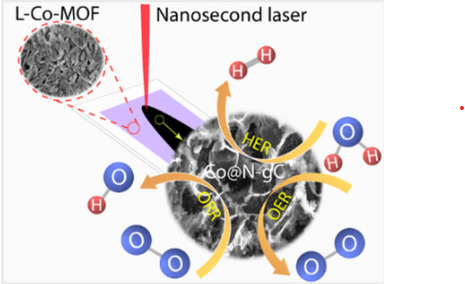
- Published in Departmental News, ENVS News, News, Research News
Advancing Next-Gen PEM Fuel Cells: Role of Nanostructured Catalysts
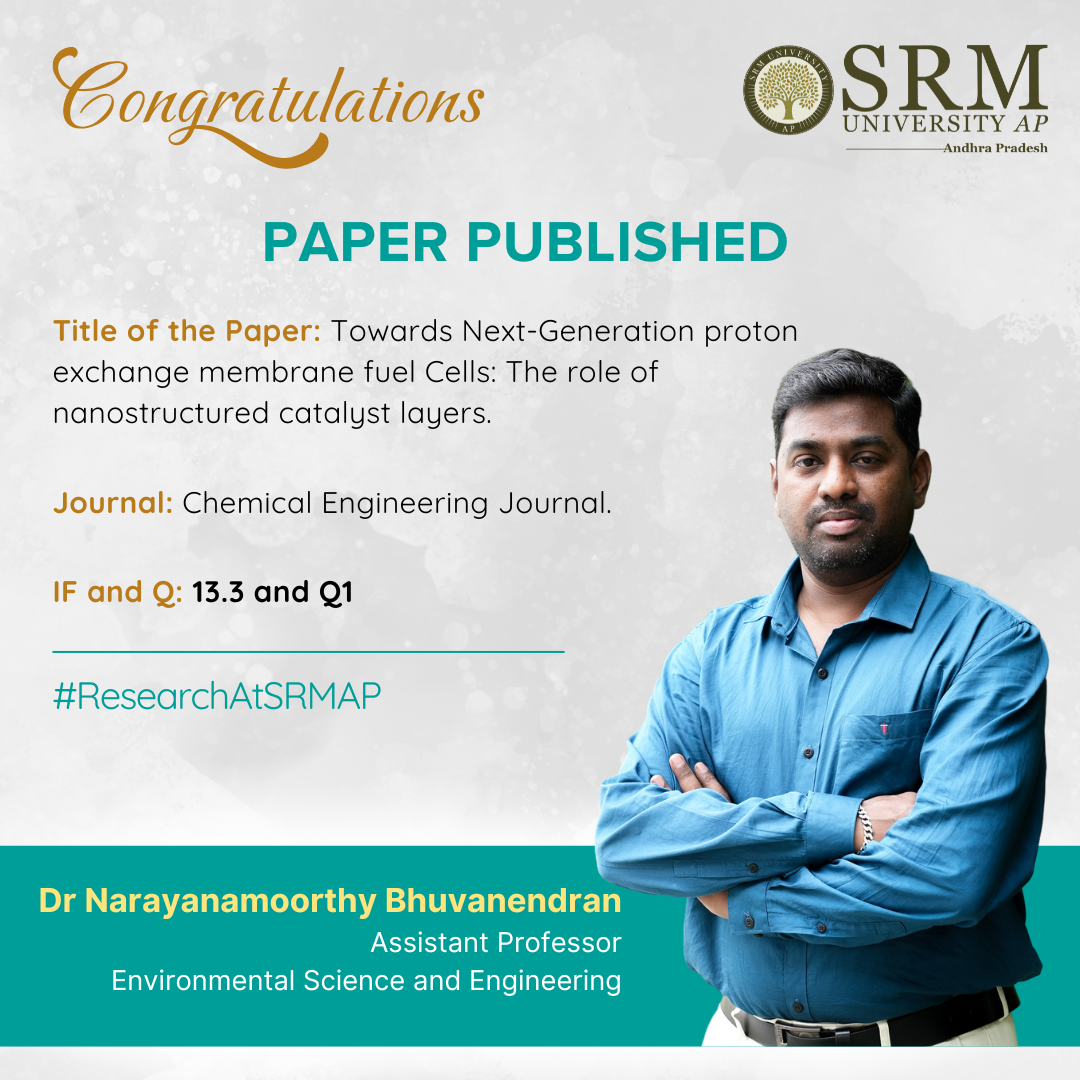 The transition to sustainable energy sources has become imperative due to the exhaustion of conventional resources caused by excessive use and their detrimental impact on the environment. Currently, alternative energy sources, such as solar, wind, nuclear, tidal, and geothermal energy, hydro have been introduced. Over the last few decades, focus has shifted to the use of hydrogen energy as a promising alternative to traditional power sources in almost all sectors requiring energy applications.
The transition to sustainable energy sources has become imperative due to the exhaustion of conventional resources caused by excessive use and their detrimental impact on the environment. Currently, alternative energy sources, such as solar, wind, nuclear, tidal, and geothermal energy, hydro have been introduced. Over the last few decades, focus has shifted to the use of hydrogen energy as a promising alternative to traditional power sources in almost all sectors requiring energy applications.
However, a major challenge holding back their widespread use is the high cost and limited performance of a key component called the catalyst layer (CL). This layer is responsible for speeding up the chemical reaction that generates electricity, but it typically requires a large amount of platinum, a rare and expensive metal and often has a thick, disordered structure that reduces efficiency.
This research, titled “Towards Next-Generation proton exchange membrane fuel Cells: The role of nanostructured catalyst layers” led by Dr. Narayanamoorthy Bhuvanendran, Assistant Professor, Department of Environmental Science and Engineering, was published in the Q1 Journal, Chemical Engineering Journal, with an Impact Factor of 13.4. The paper focuses on designing advanced nanostructured catalyst layers that are thinner, more organised, and use much less platinum. These next-generation CLs can help fuel cells perform better, last longer, and become more affordable.
The study reviews recent progress in this field, highlights innovative methods for creating these new structures, and outlines future directions to improve their practicality and environmental impact. Ultimately, this work aims to bring us closer to clean, efficient, and widely accessible fuel cell technology.
Fuel cells offer clean energy with zero emissions when using hydrogen, and higher energy efficiency than diesel or gas engines. Among them, Proton Exchange Membrane Fuel Cells (PEMFCs) are one of the most promising technologies. PEMFCs produce only water as a byproduct, making them a clean energy alternative to fossil fuels.
Abstract:
Catalyst layer (CL) is the major component of proton exchange membrane fuel cells (PEMFCs) and routinely fabricated by a catalyst ink-based processing method. Such conventional CLs typically confront low activity, unaffordable Pt loading, and severe mass transport issues due to the thick and disordered structure, hampering the widespread commercial application of PEMFCs.
Engineering of nanostructured CLs with low/ultralow Pt loading, ordered and/or ultrathin CLs, provides a highly promising pathway for overcoming these limitations. For the practical application of the nanostructured CLs in PEMFCs, this review comprehensively summarises and comments on the important research and development of nanostructured CLs over recent years, involving ordered electronic conductor-based CLs, ordered ionomer-based CLs, and ultrathin CLs.
The reviewed processes include
(i) analysing the motivation and necessity to design and fabricate nanostructured CLs based on the structure and mass transport process of conventional CLs,
(ii) scrutinising structure and composition, preparation methods, advantages, as well as
some feasible strategies for the remaining challenges of various nanostructured CLs in
detail,
(iii) the progress of single cell activity and durability of the nanostructured CLs. Finally, some perspectives on remaining challenges and future development of the nanostructured CLs are presented to guide the exploitation for the next-generation of advanced CLs of PEMFCs.
Practical implementations:
The practical objective of this study is to facilitate the development of more efficient, cost-effective, and durable proton exchange membrane fuel cells (PEMFCs) through the redesign of the catalyst layer utilising advanced nanostructures. This enhancement has the potential to substantially decrease dependence on costly platinum, reduce production expenses, and enhance the overall performance of fuel cells.
In terms of societal impact, this research contributes to the transition towards clean and sustainable energy systems, thereby reducing greenhouse gas emissions and air pollution associated with conventional fossil fuels. By making fuel cell technology more accessible and scalable, particularly for transportation and portable power applications, it supports global initiatives to combat climate change and improve energy security for future generations.
Collaborations:
Prof. Huaneng Su, Institute for Energy Research, Jiangsu University, Zhenjiang, China.
- Published in Departmental News, ENVS News, News, Research News
Biofilm-forming Marine Bacteria and their Role in Plastic Degradation
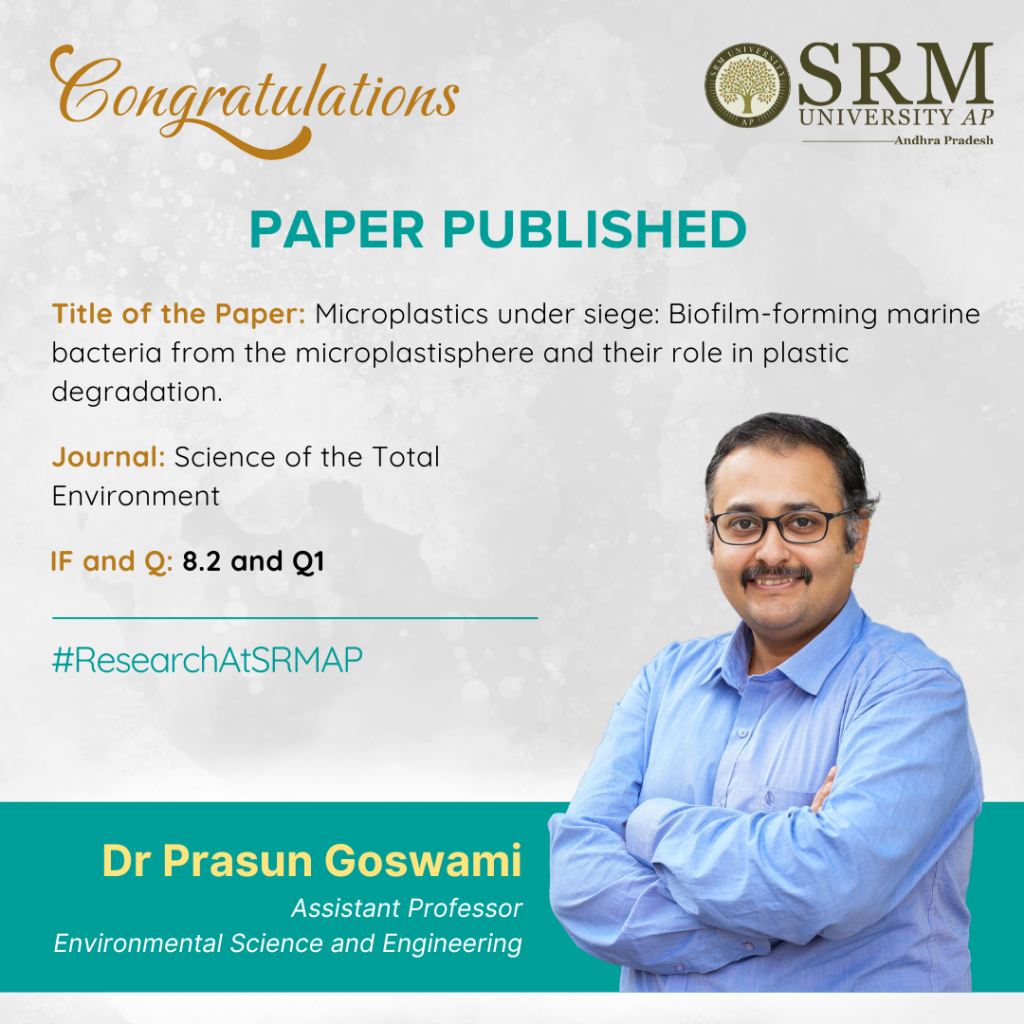
One of the major risks to the world’s ecosystems today is plastic pollution, it affects both the terrestrial and marine ecosystems alike. While India generates around 9.4 million tons of plastic annually, around 5.6 million tons are recycled, and the remaining 3.8 million tons goes uncollected or improperly disposed turning the country into a plastic pollution hotspot.
Addressing the existing gaps in understanding marine plastic and biodegradation which is the breakdown of these plastic materials by microorganisms, Dr Prasun Goswami, Assistant Professor, Department of Environmental Science and Engineering, has recently published a research paper titled “Microplastics Under Siege: Biofilm-forming Marine Bacteria from the Micro Plastisphere and their Role in Plastic Degradation”. The paper was published in the Q1 journal, Science of the Total Environment, with an Impact Factor of 8.2.
Over a period of time plastic debris degrade into smaller pieces, eventually forming microplastics (less than 5mm) which are increasingly found in water sources, including drinking water, and pose a potential threat to human health and aquatic life. Some studies suggest that ingested microplastics may have negative health effects, including reproductive damage. Microbial biodegradation has been regarded as one of the effective ways to deal with plastic pollution.
Abstract
Microplastics, laden with toxins and microorganisms, threaten marine ecosystems by affecting both living organisms and environmental processes. This study explores the diversity and plastic-degrading potential of culturable bacteria colonizing microplastics collected from three coastal sites of the Andaman and Nicobar Islands. Low-density polyethylene (LDPE) was the most prevalent polymer identified in the plastic debris. Among 24 bacterial isolates screened, strain NIOT-MP-52 demonstrated the highest LDPE degradation efficiency (10.79%) which means breaking down the plastic and was subjected to detailed characterization. Analytical techniques (FT-IR, SEM, AFM, DSC) confirmed microbial degradation through surface alterations and thermal changes. The findings underscore the promising role of marine bacteria in biodegrading plastics, offering potential solutions for sustainable plastic waste management.
Practical Implementations of the Research
This research offers a sustainable solution to marine plastic pollution by identifying native bacteria capable of degrading low-density polyethylene (LDPE), a common plastic pollutant. The most efficient strain, NIOT-MP-52, showed significant potential for breaking down plastic, indicating its practical use in eco-friendly bioremediation systems like biofilters or wastewater treatment setups. Socially, this approach supports healthier marine ecosystems, reduces human exposure to microplastics, and encourages nature-based waste management strategies, potentially creating green jobs in coastal communities.
Collaborations
This research was originally carried out at the Atal Centre for Ocean Science and Technology for Islands, National Institute of Ocean Technology, Ministry of Earth Sciences, Government of India, Sri Vijaya Puram, India. National Institute of Ocean Technology, Ministry of Earth Sciences, Government of India, Chennai, India.
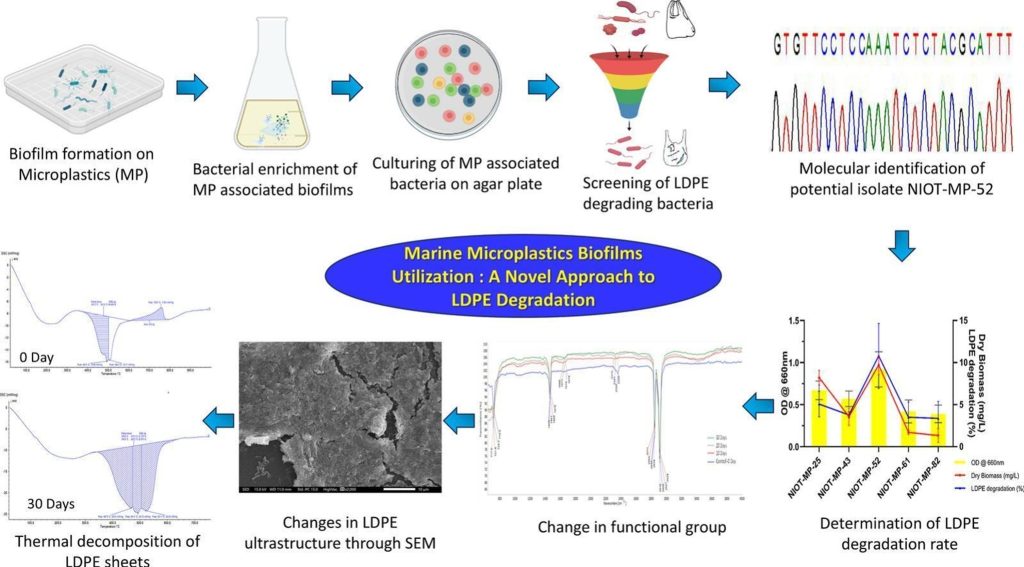
- Published in Departmental News, ENVS News, News, Research News
Myco-remediation Strategies: Green Solution to Soil Pollution
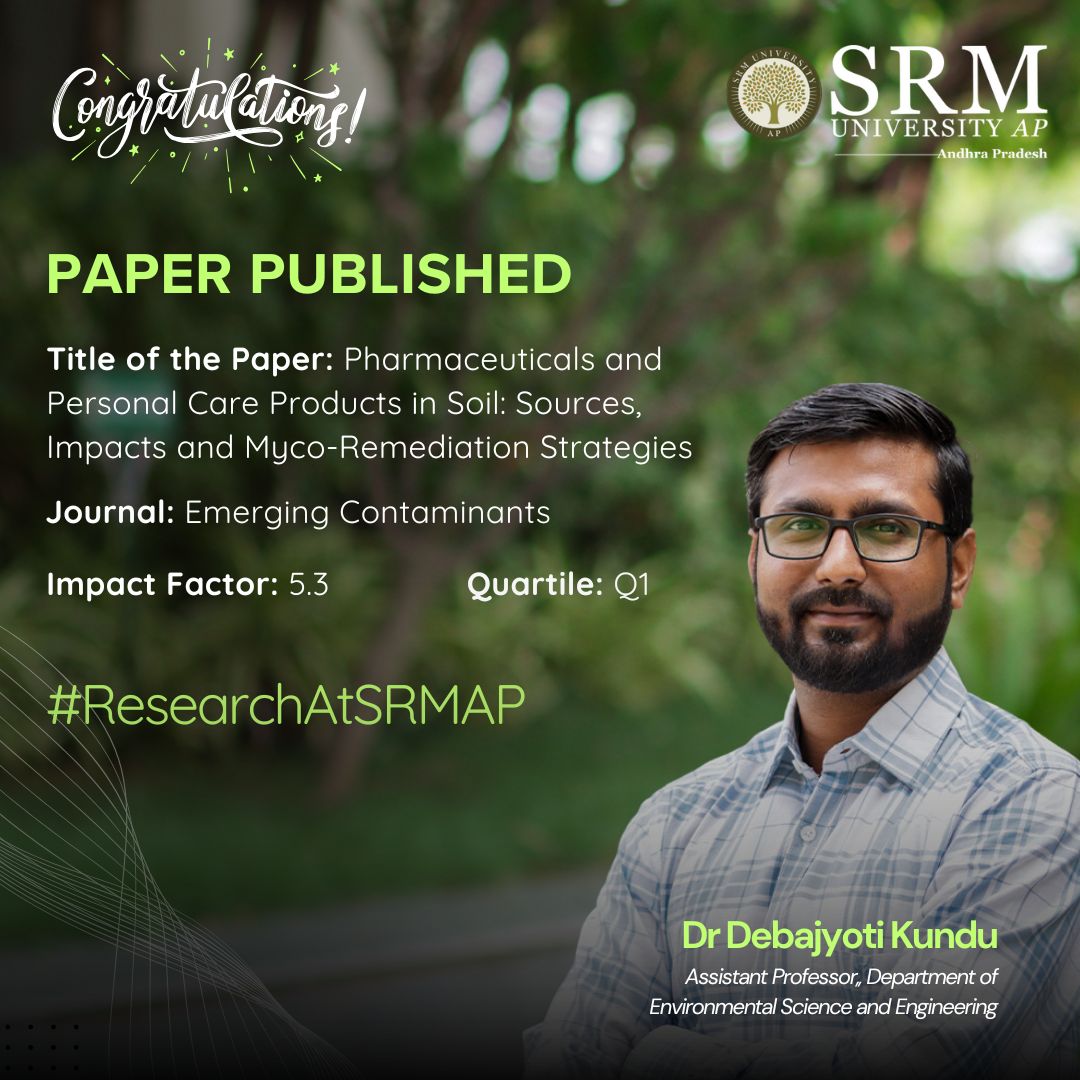 Dr Debajyoti Kundu, Assistant Professor at the Department of Environmental Science and Engineering in his research paper, Pharmaceuticals and Personal Care Products in Soil: Sources, Impacts and Myco-remediation Strategies, speaks of the innovative solutions to tackle contamination of soil. Dr Kundu’s research focuses on leveraging natural processes of fungi to promote sustainable environmental management.
Dr Debajyoti Kundu, Assistant Professor at the Department of Environmental Science and Engineering in his research paper, Pharmaceuticals and Personal Care Products in Soil: Sources, Impacts and Myco-remediation Strategies, speaks of the innovative solutions to tackle contamination of soil. Dr Kundu’s research focuses on leveraging natural processes of fungi to promote sustainable environmental management.
Abstract:
Bioremediation is a sustainable approach for mitigating pharmaceutical and personal care product (PPCP) contamination in soil. This review highlights mycoremediation as an advanced fungal-based strategy for PPCP degradation. Fungi possess unique enzymatic pathways and metabolic diversity, allowing them to break down persistent pollutants in challenging environmental conditions. The paper discusses key fungal species, enzymatic mechanisms, environmental factors influencing degradation efficiency, and innovative biotechnological approaches such as myco-nanotechnology and enzyme engineering. By integrating these advancements with circular economy principles, this research underscores fungi’s role in sustainable environmental management.
Explanation in layperson’s terms:
Pharmaceuticals and personal care products (PPCPs), such as medicines, soaps, and cosmetics, often end up in the soil through wastewater and agricultural runoff. These chemicals persist in the environment, harming ecosystems and potentially entering our food supply. Our research explores how fungi, nature’s recyclers, can help clean up these pollutants. Certain fungi produce special enzymes that break down harmful substances into harmless compounds. By harnessing this natural process, we propose eco-friendly solutions to reduce pollution and protect soil and water quality for future generations.
Practical and Social Implications:
Mycoremediation offers a sustainable, cost-effective solution for removing PPCPs from soil, protecting water quality, and reducing human exposure to contaminants. By preventing pollutant uptake in crops, it enhances food safety and supports sustainable agriculture. This research also informs policies on wastewater treatment and pollution control, promoting eco-friendly remediation technologies for environmental and public health protection.
Collaborations:
This research is a collaborative effort involving experts from:
- Voice of Environment (VoE), Guwahati, Assam
- University of North Bengal, Darjeeling, West Bengal
- RCC Institute of Information Technology, Kolkata
- Sukanta Mahavidyalaya, University of North Bengal, Dhupguri, West Bengal
- SPMR College of Commerce, Jammu
- SRM University-AP, Andhra Pradesh
- CSIR – National Environmental Engineering Research Institute (CSIR-NEERI), Nagpur, India
Future Research Plans:
Future research will focus on scaling up my coremediation for field applications, optimizing fungal enzyme efficiency through enzyme engineering, and exploring microbial consortia for enhanced pollutant degradation. Myco-nanotechnology will be further developed to improve fungal stability and reusability. Additionally, studies will assess long-term soil health impacts and support policy frameworks for integrating fungal bioremediation into wastewater treatment and agricultural practices.
- Published in Departmental News, ENVS News, News, Research News
ESE 2025: Inspiring Innovations
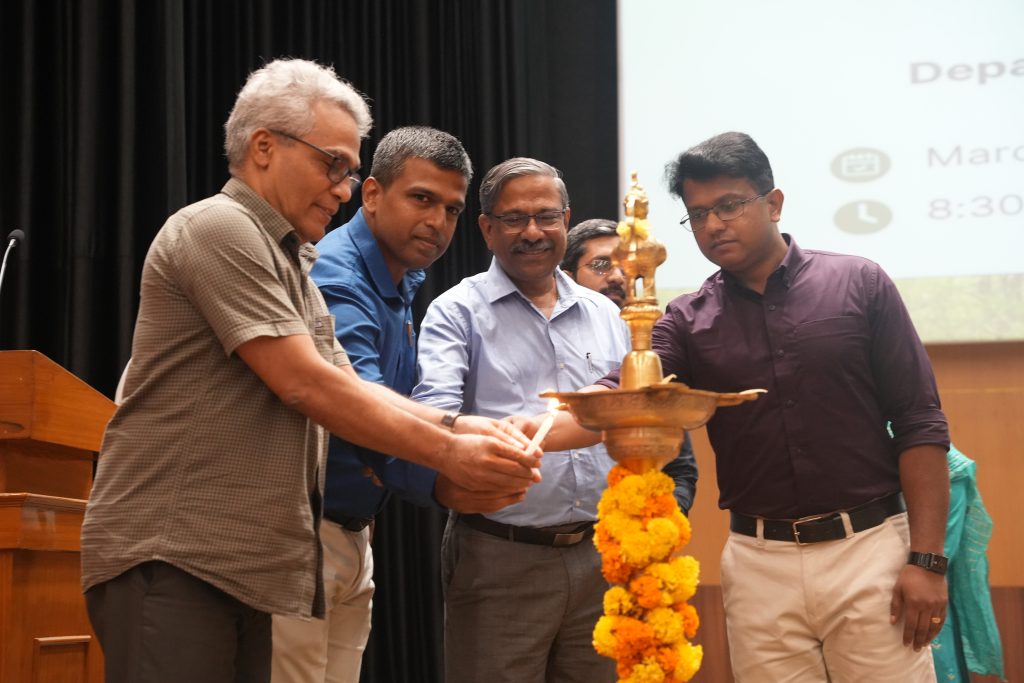 The Department of Environmental Science and Engineering in collaboration with the Directorate of Admissions have jointly organised the second edition of the Environmental Sustainability Exhibition 2025. Registrar, Dr R Premkumar declared the Environmental Sustainability Exhibition open; Deans-SEAS, Prof. C V Tomy along with Head of the Department of Environmental Science and Engineering, Dr Rangabhashiyam Selvasembian, Programme Convenors, other members of the faculty, staff and students bore witness to this noble cause.
The Department of Environmental Science and Engineering in collaboration with the Directorate of Admissions have jointly organised the second edition of the Environmental Sustainability Exhibition 2025. Registrar, Dr R Premkumar declared the Environmental Sustainability Exhibition open; Deans-SEAS, Prof. C V Tomy along with Head of the Department of Environmental Science and Engineering, Dr Rangabhashiyam Selvasembian, Programme Convenors, other members of the faculty, staff and students bore witness to this noble cause.
The event brought together 207 participants from prestigious colleges and universities across 11 states to address a shared mission of ensuring a safe and sustainable future. The exhibition featured over 50+ exhibits from students representing institutions such as the College of Forestry at Kerala Agricultural University; Singhaniya University, Rajasthan; Lovely Professional University, Punjab, Doon Global University, Dehradun; SR University, Warangal, Vignan University, Vadlamudi and Andhra Loyola College, Andhra Pradesh among others.
The event also featured poster presentations, hands-on training, campus and laboratory visits along with the exhibition. The exhibition also featured an exciting prize pool worth Rs 20,000, Rs 15,000 and Rs 10,000 for the first three winners. The team from Doon Global University, Dehradun; Vignan University, Vadlamudi, Andhra Pradesh and; SR University Warangal, Telangana bagged the first, second and third prize respectively.
Prof. C V Tomy, Dean of the School of Engineering and Sciences, remarked, “What you can save today would be your deposit for tomorrow.” He went on to emphasise the importance of making sustainable choices and encouraged the students to cultivate a sustainable mindset. Associate Professor and Head, Department of Environmental Science and Engineering, Dr Rangabhasiyam in his address stated, “ESE-2025 serves as an exceptional platform for students across the country to present innovative ideas and initiatives for building a sustainable future.” He added, the exhibition motivates the students to showcase their products, learn from experts and contribute to the ongoing sustainability.
Programme convenor, Dr Shoji D Thottathil highlighted the objective of the Exhibition. He stated that, “An exhibition of this calibre is an avenue for people to discuss solutions to environmental problems. Exhibitions such as these transform ideas into innovations.” He emphasised that sustainability is interdisciplinary and requires collaboration among diverse minds.
ESE 2025 served as a call to action asking society to rethink their approach towards environmental challenges in sustainable development.
- Published in Departmental News, ENVS News, News


